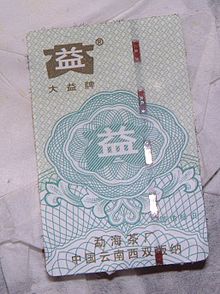- Menghai tea factory
-
Menghai Tea Factory (Chinese: 勐海茶厂; pinyin: měnghăi cháchăng) is a tea factory producing pu'er tea located in Menghai, Yunnan, China. The factory is well known for its old raw pu-erh cakes and is highly reputed in the tea industry of China.
Contents
History
Menghai Tea Factory was founded in 1940 and is located in Menghai County, Xishuangbanna Prefecture, Yunnan Province, China (中国云南西双版纳勐海县). The factory was originally called Fo Hai Tea Factory (佛海茶厂), but changed its name to Menghai Tea Factory in 1953 with the establishment of the Xishuangbanna autonomous prefecture.[1]
Menghai Tea Factory is credited as being one of the first two factories to make "cooked" (熟茶, shúchá) pu'er tea in 1973 (the other factory was Kunming Tea Factory). As the tea factory industry in China privatized in the late 1980s through the 1990s, Menghai Tea Factory adopted its "Dayi" (大益) logo and went fully private in 1996. Currently, Menghai Tea Factory is owned by The Bowin Company, who purchased Menghai Tea Industry Co. Ltd and Menghai Tea Factory in October 2004.[1]
Products
Menghai Tea Factory is perhaps the most widely known producer of compressed and loose pu'er tea, including túochá (沱茶, "Bowl-shaped Tea"(?)), bĭngchá (饼茶, "Disc Tea"), and other compressed shapes. Vintage Bĭngchá from Menghai Tea Factory are perhaps the most highly prized pu'er teas produced in the 1970s and 1980s. Current productions from Menghai Tea Factory remain popular, even with the trend of pu'er collectors favoring smaller producers. Because of the high prices fetched by both new and old Menghai products, Menghai products often suffer from widespread counterfeiting. In 2006, Menghai began issuing microprinted tickets in their pu'er cakes in an attempt to throw off counterfeiters.
Recipes
Like Xiaguan Tea Factory and many other formerly government-owned pu'er factories, Menghai produces many cakes by recipe, indicated by number. Recipe numbers are formulated in a four-digit numeric format: ####. The first two digits represent the year the recipe was first produced, the third digit the grade of leaves used in the recipe, and the last digit represents the factory (2 for Menghai Tea Factory). 7542, for example, would be a recipe from 1975 using fourth-grade tea leaf made by Menghai Tea Factory.
Some examples of bĭngchá recipes are below. Menghai also produces some zhuānchá (砖茶, "brick tea") and túochá by recipe as well. Many pu'er series by Menghai—especially newer series—are not referenced by recipe number.
Bĭngchá recipes (partial list):
Raw: 7432, 7532, 7572, 7582, 7742, 8542, 8582, 8972, 0622
Cooked: 7262, 7552, 7562, 7572, 7592, 7632, 7672, 7752, 8562, 8592, 0532, 0562
Brands
Menghai Tea Factory previously produced its teas under the zhōngchá label of the state-run China National Native Produce & Animal Byproducts Import & Export (CNNP), but registered its own brand, Dayi, in June 1989, and began producing exclusively under this label in 1996. While some Menghai labels contain other more prominent labels, such as the Menghai peacock, the Dayi brand is always found on these labels as well.
Image gallery
References
- ^ a b "Meng Hai Tea Factory - A Very Short History". http://chadao.blogspot.com/2007/07/meng-hai-tea-factory-very-short-history.html., Dan Da Tee Man (March 23, 2006)
Sources
- Pu-Erh.net provided information on this factory, including brands, recipe numbers, and much help in Chinese translations.
External links
Categories:- Chinese tea
- China tea factories
- Chinese tea grown in Yunnan
Wikimedia Foundation. 2010.



